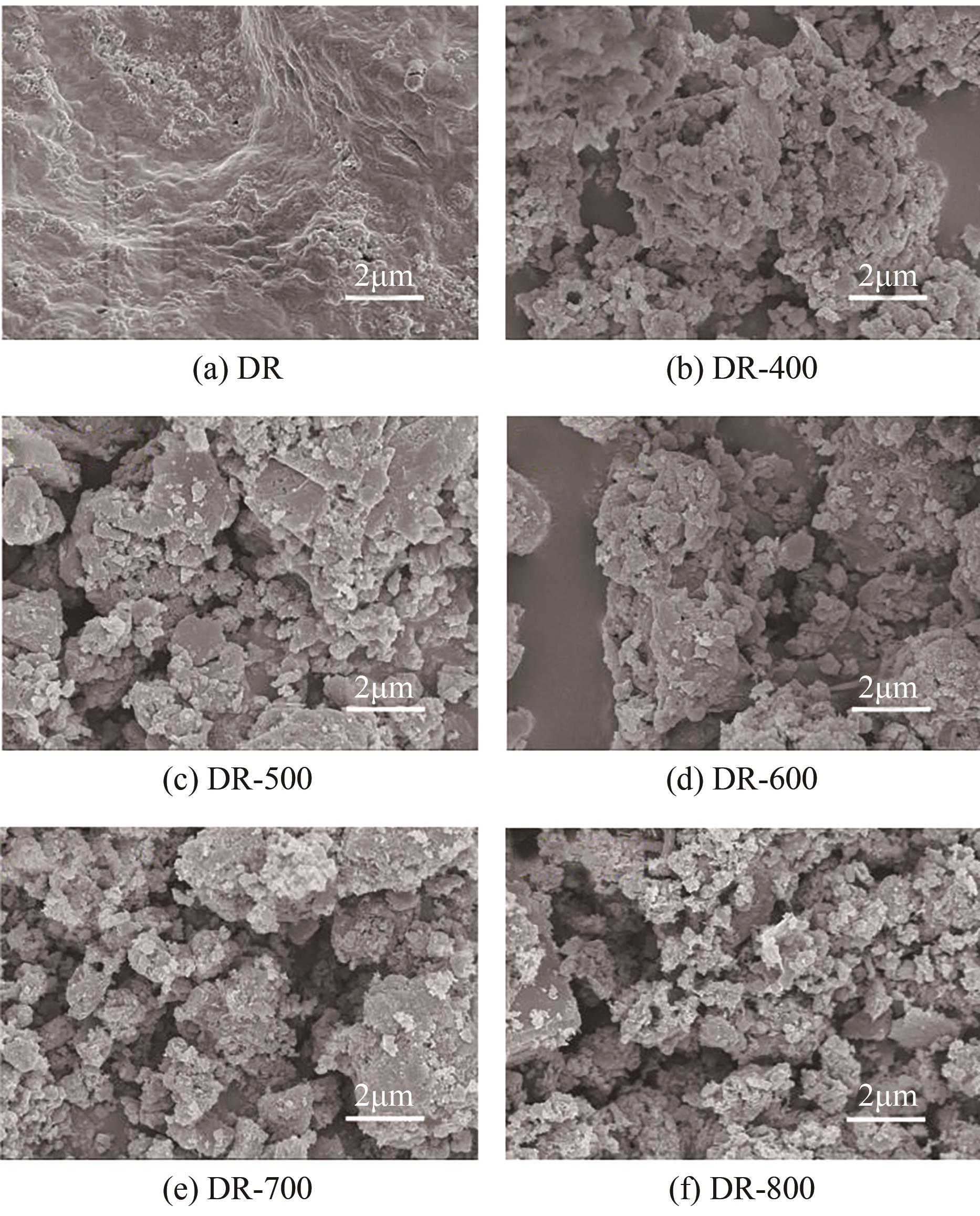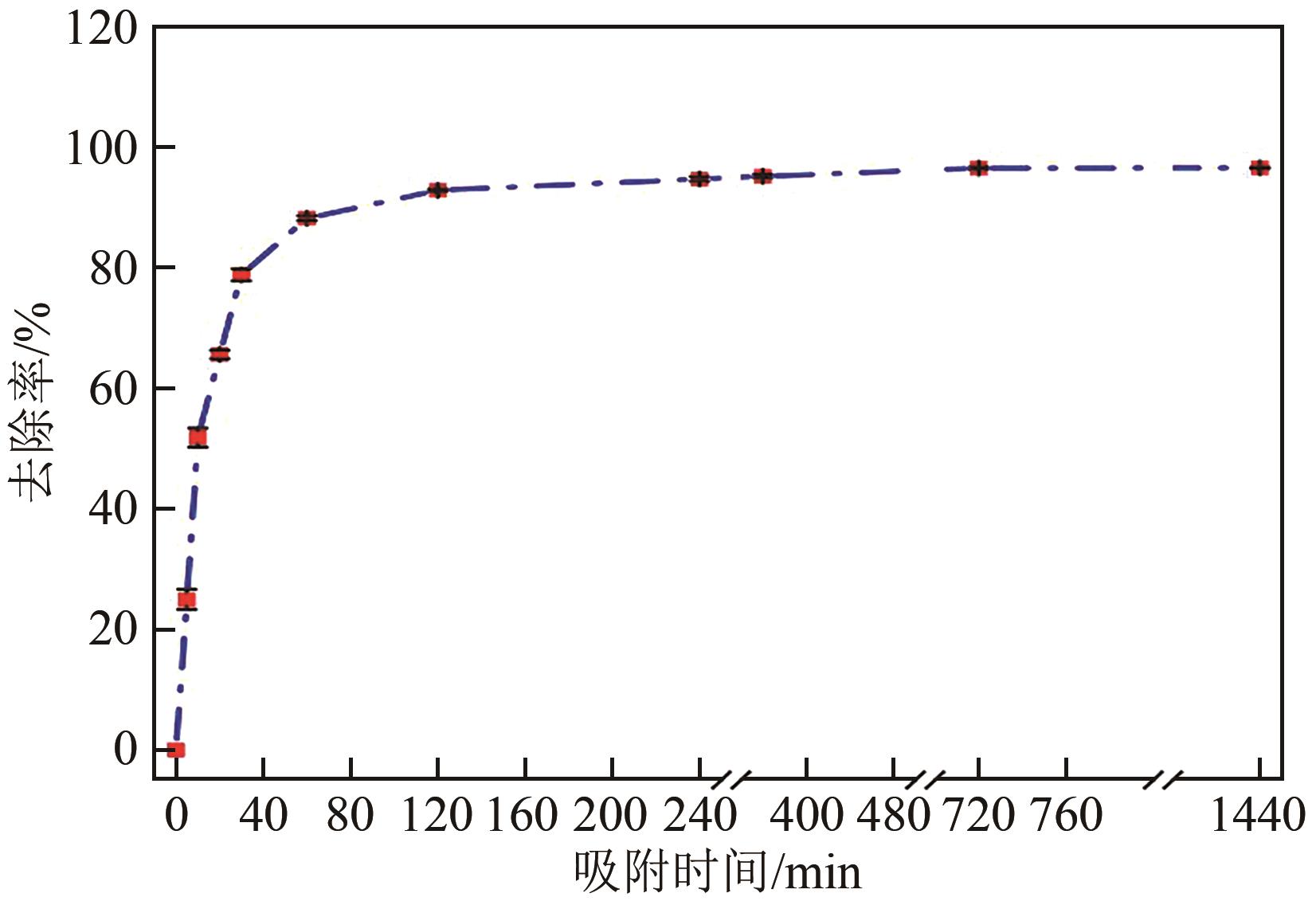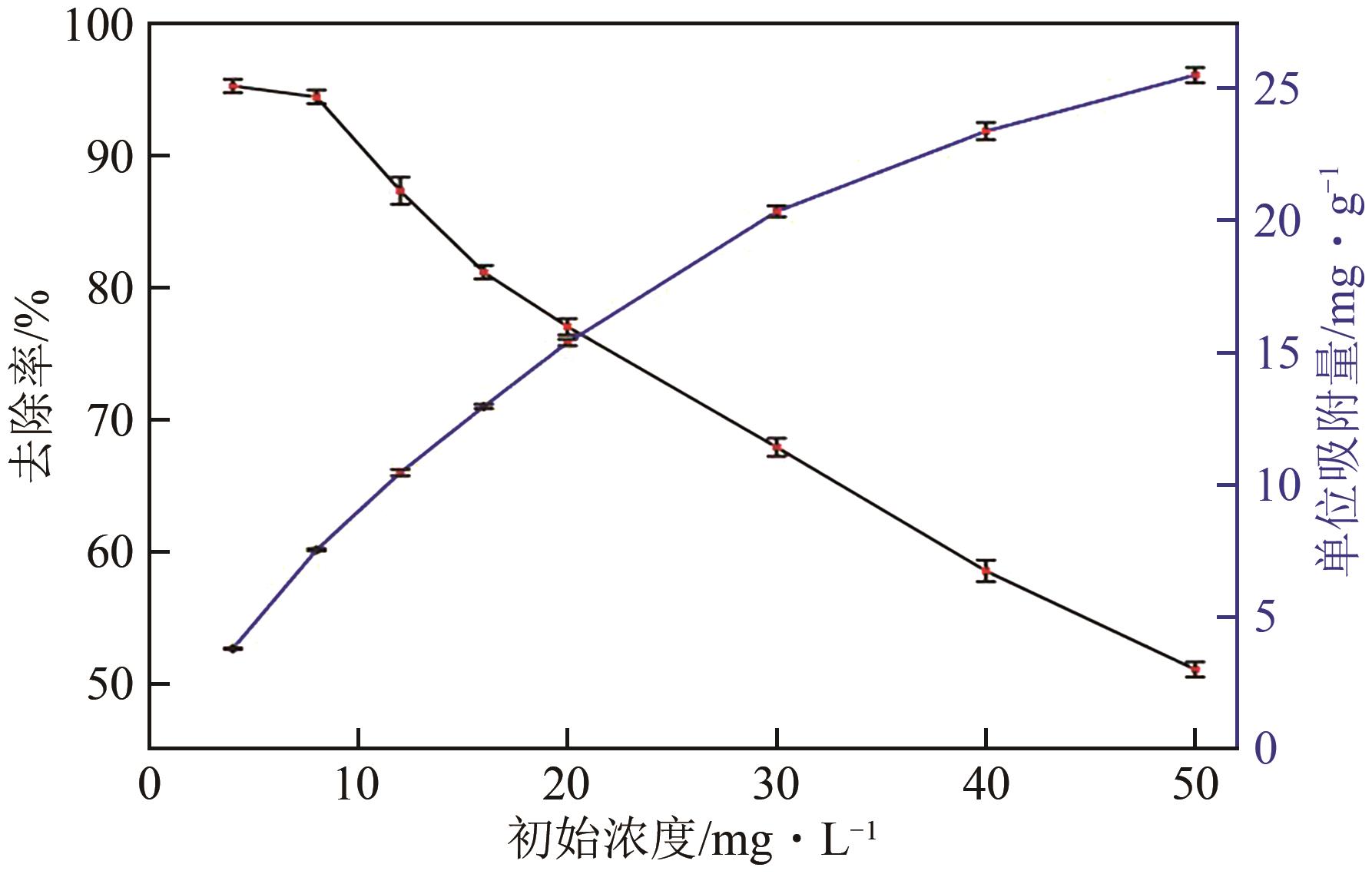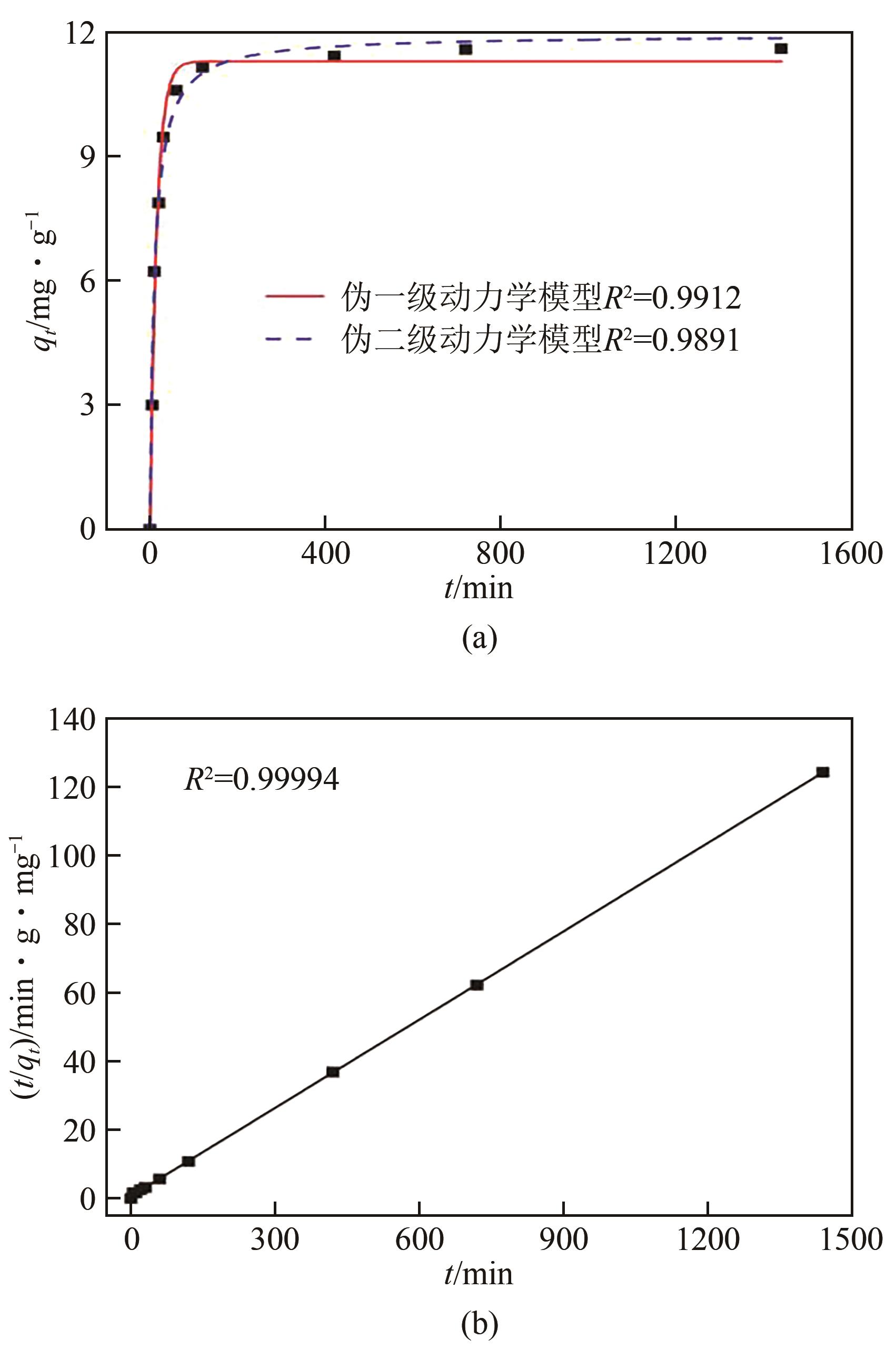化工进展 ›› 2023, Vol. 42 ›› Issue (4): 2160-2170.DOI: 10.16085/j.issn.1000-6613.2022-1152
餐厨厌氧沼渣生物炭吸附盐酸环丙沙星
王玉1,2( ), 余广炜1,3(
), 余广炜1,3( ), 江汝清1, 黎长江1,4, 林佳佳1,2, 邢贞娇1
), 江汝清1, 黎长江1,4, 林佳佳1,2, 邢贞娇1
- 1.中国科学院城市环境研究所,中国科学院城市污染物转化重点实验室,福建 厦门 361021
2.中国科学院大学,北京 100049
3.福建省城市固体废弃物资源化工程技术研究中心,福建 厦门 361021
4.福建农林大学 生命科学学院,福建 福州 350002
-
收稿日期:2022-06-20修回日期:2022-07-27出版日期:2023-04-25发布日期:2023-05-08 -
通讯作者:余广炜 -
作者简介:王玉(1996—),男,硕士研究生,主要研究方向为固体废弃物资源化利用与污染物控制。E-mail:yuwang@iue.ac.cn。 -
基金资助:国家重点研发计划(2020YFC1908904);中国科学院A类战略性先导科技专项(XDA23020504);福建省自然科学基金(2019J01135);福建省STS项目(2021T3069)
Adsorption of ciprofloxacin hydrochloride by biochar from food waste digestate residues
WANG Yu1,2( ), YU Guangwei1,3(
), YU Guangwei1,3( ), JIANG Ruqing1, LI Changjiang1,4, LIN Jiajia1,2, XING Zhenjiao1
), JIANG Ruqing1, LI Changjiang1,4, LIN Jiajia1,2, XING Zhenjiao1
- 1.CAS Key Laboratory of Urban Pollutant Conversion, Institute of Urban Environment, Chinese Academy of Sciences, Xiamen 361021, Fujian, China
2.University of Chinese Academy of Sciences, Beijing 100049, China
3.Fujian Municipal Solid Waste Resource Recovery Technology Research Center, Xiamen 361021, Fujian, China
4.College of Life Sciences, Fujian Agriculture and Forestry University, Fuzhou 350002, Fujian, China
-
Received:2022-06-20Revised:2022-07-27Online:2023-04-25Published:2023-05-08 -
Contact:YU Guangwei
摘要:
将餐厨厌氧沼渣在5种温度(400℃、500℃、600℃、700℃和800℃)下热解制备生物炭,解析其形貌特征、孔隙结构以及表面官能团等变化规律,探究其对水溶液中的盐酸环丙沙星(CIP)吸附效果,并通过吸附动力学和等温吸附特性探究其吸附机制。结果表明,在700℃下热解制备的生物炭(DR-700)疏松多孔,表面官能团丰富且具有更好的孔隙结构和微观结构,在所有生物炭中对于CIP的吸附效果最好。吸附去除率可达95.09%,可用作良好的吸附材料。DR-700对于CIP的吸附更符合伪一阶动力学和Freundlich等温线模型,表明物理吸附可能是CIP在DR-700吸附的主要机制,主要归功于丰富的比表面积。而同时存在的化学吸附则可能是由于阳离子交换相互作用、静电相互作用、π-π相互作用、疏水和氢键共同作用。因此,利用餐厨厌氧沼渣热解制备生物炭对水溶液中的CIP具有良好的吸附净化效果,这不但可以为抗生素废水低成本处理提供新的材料,还为解决餐厨垃圾厌氧发酵末端产物的资源化利用问题提供一种新方案,具有良好的应用潜力。
中图分类号:
引用本文
王玉, 余广炜, 江汝清, 黎长江, 林佳佳, 邢贞娇. 餐厨厌氧沼渣生物炭吸附盐酸环丙沙星[J]. 化工进展, 2023, 42(4): 2160-2170.
WANG Yu, YU Guangwei, JIANG Ruqing, LI Changjiang, LIN Jiajia, XING Zhenjiao. Adsorption of ciprofloxacin hydrochloride by biochar from food waste digestate residues[J]. Chemical Industry and Engineering Progress, 2023, 42(4): 2160-2170.
| 抗生素种类 | 分子式 | 分子量 | 离子性 | 分子结构 |
|---|---|---|---|---|
| 盐酸环丙沙星 | C17H19ClFN3O3 | 367.8 | 阴离子 |  |
表1 CIP的理化性质
| 抗生素种类 | 分子式 | 分子量 | 离子性 | 分子结构 |
|---|---|---|---|---|
| 盐酸环丙沙星 | C17H19ClFN3O3 | 367.8 | 阴离子 |  |
| 沼渣生物炭 | 热解产率/% | 工业分析(质量分数)/% | 元素分析(质量分数)/% | H/C | N/C | ||||||
|---|---|---|---|---|---|---|---|---|---|---|---|
| 灰分 | 挥发分 | 固定碳 | N | C | H | S | O | ||||
| DR | — | 48.05 | 49.41 | 2.54 | 3.49 | 22.72 | 3.22 | 0.39 | 22.13 | 1.70 | 0.13 |
| DR-400 | 65.97 | 69.34 | 26.42 | 4.25 | 1.20 | 13.01 | 1.30 | 0.41 | 14.75 | 1.20 | 0.08 |
| DR-500 | 64.97 | 70.27 | 22.62 | 7.11 | 1.27 | 13.85 | 1.25 | 0.51 | 12.85 | 1.08 | 0.08 |
| DR-600 | 62.27 | 71.86 | 19.45 | 8.69 | 0.91 | 13.28 | 0.89 | 0.52 | 12.55 | 0.80 | 0.06 |
| DR-700 | 52.23 | 81.71 | 16.00 | 2.29 | 0.34 | 8.22 | 1.09 | 0.65 | 8.00 | 1.59 | 0.04 |
| DR-800 | 51.57 | 84.03 | 13.48 | 2.49 | 0.26 | 7.71 | 1.17 | 0.52 | 6.31 | 1.82 | 0.03 |
表2 餐厨厌氧沼渣及生物炭基本理化性质
| 沼渣生物炭 | 热解产率/% | 工业分析(质量分数)/% | 元素分析(质量分数)/% | H/C | N/C | ||||||
|---|---|---|---|---|---|---|---|---|---|---|---|
| 灰分 | 挥发分 | 固定碳 | N | C | H | S | O | ||||
| DR | — | 48.05 | 49.41 | 2.54 | 3.49 | 22.72 | 3.22 | 0.39 | 22.13 | 1.70 | 0.13 |
| DR-400 | 65.97 | 69.34 | 26.42 | 4.25 | 1.20 | 13.01 | 1.30 | 0.41 | 14.75 | 1.20 | 0.08 |
| DR-500 | 64.97 | 70.27 | 22.62 | 7.11 | 1.27 | 13.85 | 1.25 | 0.51 | 12.85 | 1.08 | 0.08 |
| DR-600 | 62.27 | 71.86 | 19.45 | 8.69 | 0.91 | 13.28 | 0.89 | 0.52 | 12.55 | 0.80 | 0.06 |
| DR-700 | 52.23 | 81.71 | 16.00 | 2.29 | 0.34 | 8.22 | 1.09 | 0.65 | 8.00 | 1.59 | 0.04 |
| DR-800 | 51.57 | 84.03 | 13.48 | 2.49 | 0.26 | 7.71 | 1.17 | 0.52 | 6.31 | 1.82 | 0.03 |
| 温度/℃ | Freundlich方程 | Langmuir方程 | ||||
|---|---|---|---|---|---|---|
| KF | 1/n | R2 | KL | Qmax/mg·g-1 | R2 | |
| 25 | 8.95 | 0.3497 | 0.9904 | 0.4901 | 24.57 | 0.9286 |
| 35 | 10.39 | 0.3199 | 0.9630 | 0.8286 | 24.17 | 0.9607 |
| 45 | 10.20 | 0.3221 | 0.9604 | 0.4530 | 33.46 | 0.9752 |
表3 不同温度下DR-700对CIP吸附等温线拟合参数
| 温度/℃ | Freundlich方程 | Langmuir方程 | ||||
|---|---|---|---|---|---|---|
| KF | 1/n | R2 | KL | Qmax/mg·g-1 | R2 | |
| 25 | 8.95 | 0.3497 | 0.9904 | 0.4901 | 24.57 | 0.9286 |
| 35 | 10.39 | 0.3199 | 0.9630 | 0.8286 | 24.17 | 0.9607 |
| 45 | 10.20 | 0.3221 | 0.9604 | 0.4530 | 33.46 | 0.9752 |
| 生物炭 | 实际吸附量/mg·g-1 | 伪一级动力学方程 | 伪二级动力学方程 | ||||
|---|---|---|---|---|---|---|---|
| k1/min-1 | qe/mg·g-1 | R2 | k2/g·(mg·min)-1 | Qe/mg·g-1 | R2 | ||
| DR700 | 11.15 | 0.066 | 11.28 | 0.9912 | 0.0083 | 11.92 | 0.9891 |
表4 DR-700吸附CIP的伪一级、伪二级动力学参数
| 生物炭 | 实际吸附量/mg·g-1 | 伪一级动力学方程 | 伪二级动力学方程 | ||||
|---|---|---|---|---|---|---|---|
| k1/min-1 | qe/mg·g-1 | R2 | k2/g·(mg·min)-1 | Qe/mg·g-1 | R2 | ||
| DR700 | 11.15 | 0.066 | 11.28 | 0.9912 | 0.0083 | 11.92 | 0.9891 |
| 1 | AKHTAR L, AHMAD M, IQBAL S, et al. Biochars’ adsorption performance towards moxifloxacin and ofloxacin in aqueous solution: Role of pyrolysis temperature and biomass type[J]. Environmental Technology & Innovation, 2021, 24: 101912. |
| 2 | KIM H, HWANG Y S, SHARMA V K. Adsorption of antibiotics and iopromide onto single-walled and multi-walled carbon nanotubes[J]. Chemical Engineering Journal, 2014, 255: 23-27. |
| 3 | LE-MINH N, KHAN S J, DREWES J E, et al. Fate of antibiotics during municipal water recycling treatment processes[J]. Water Research, 2010, 4415: 4295-4323. |
| 4 | ARIKAN O A. Degradation and metabolization of chlortetracycline during the anaerobic digestion of manure from medicated calves[J]. Journal of Hazardous Materials, 2008, 1582: 485-490. |
| 5 | KOYUNCU I, ARIKAN O A, WIESNER M R, et al. Removal of hormones and antibiotics by nanofiltration membranes[J]. Journal of Membrane Science, 2008, 3091: 94-101. |
| 6 | CARLESI J C, FINO D, SPECCHIA V, et al. Electrochemical removal of antibiotics from wastewaters[J]. Applied Catalysis B: Environmental, 2007, 701: 479-487. |
| 7 | NAVALON S, ALVARO M, GARCIA H. Reaction of chlorine dioxide with emergent water pollutants: Product study of the reaction of three β-lactam antibiotics with ClO2 [J]. Water Research, 2008, 428: 1935-1942. |
| 8 | SU S N, GUO W L, YI C L, et al. Degradation of amoxicillin in aqueous solution using sulphate radicals under ultrasound irradiation[J]. Ultrasonics Sonochemistry, 2012, 193: 469-474. |
| 9 | YU F, MA J, WANG J, et al. Magnetic iron oxide nanoparticles functionalized multi-walled carbon nanotubes for toluene, ethylbenzene and xylene removal from aqueous solution[J]. Chemosphere, 2016, 146: 162-172. |
| 10 | ZHU X D, LIU Y C, QIAN F, et al. Preparation of magnetic porous carbon from waste hydrochar by simultaneous activation and magnetization for tetracycline removal[J]. Bioresource Technology, 2014, 154: 209-214. |
| 11 | LIU M K, LIU Y Y, BAO D D, et al. Effective removal of tetracycline antibiotics from water using hybrid carbon membranes[J]. Scientific Reports, 2017, 7: 43717. |
| 12 | ZHANG M C, LI A M, ZHOU Q, et al. Effect of pore size distribution on tetracycline adsorption using magnetic hypercrosslinked resins[J]. Microporous and Mesoporous Materials, 2014, 184: 105-111. |
| 13 | RODRíGUEZ D R, CARRO A M, CHIANELLA I, et al. Oxytetracycline recovery from aqueous media using computationally designed molecularly imprinted polymers[J]. Analytical and Bioanalytical Chemistry, 2016, 40824: 6845-6856. |
| 14 | 刘敏敏, 安栋, 侯立安, 等. 沸石基介孔分子筛的制备及其去除四环素的效能[J]. 上海应用技术学院学报(自然科学版), 2016, 16(3): 222-227. |
| LIU M M, AN D, HOU A D, et al. The synthesis and tetracycline antibiotics removal from water by novel zeolite-based mesoporous molecular sieves[J]. Journal of Shanghai Institute of Technology (Natural Science), 2016, 16(3): 222-227. | |
| 15 | AHMAD M, RAJAPAKSHA A U, LIM J E, et al. Biochar as a sorbent for contaminant management in soil and water: A review[J]. Chemosphere, 2014, 99: 19-33. |
| 16 | LANGMUIR I. The constitution and fundamental properties of solids and liquids. Part I. Solids[J]. Journal of the American Chemical Society, 1916, 3811: 2221-2295. |
| 17 | AHMAD M, LEE S S, DOU X M, et al. Effects of pyrolysis temperature on soybean stover- and peanut shell-derived biochar properties and TCE adsorption in water[J]. Bioresource Technology, 2012, 118: 536-544. |
| 18 | CAYUELA M L, JEFFERY S, VAN Z L. The molar H: Corg ratio of biochar is a key factor in mitigating N2O emissions from soil[J]. Agriculture, Ecosystems & Environment, 2015, 202: 135-138. |
| 19 | JIN J W, LI Y N, ZHANG J Y, et al. Influence of pyrolysis temperature on properties and environmental safety of heavy metals in biochars derived from municipal sewage sludge[J]. Journal of Hazardous Materials, 2016, 320: 417-426. |
| 20 | LU H L, ZHANG W H, WANG S Z, et al. Characterization of sewage sludge-derived biochars from different feedstocks and pyrolysis temperatures[J]. Journal of Analytical and Applied Pyrolysis, 2013, 102: 137-143. |
| 21 | AFZAL M Z, SUN X F, LIU J, et al. Enhancement of ciprofloxacin sorption on chitosan/biochar hydrogel beads[J]. Science of the Total Environment, 2018, 639: 560-569. |
| 22 | WANG J, CHEN Z M, CHEN B L. Adsorption of polycyclic aromatic hydrocarbons by graphene and graphene oxide nanosheets[J]. Environmental Science & Technology, 2014, 489: 4817-4825. |
| 23 | JI L L, CHEN W, DUAN L, et al. Mechanisms for strong adsorption of tetracycline to carbon nanotubes: A comparative study using activated carbon and graphite as adsorbents[J]. Environmental Science & Technology, 2009, 437: 2322-2327. |
| 24 | HAMADEEN H M, ELKHATIB E A. New nanostructured activated biochar for effective removal of antibiotic ciprofloxacin from wastewater: Adsorption dynamics and mechanisms[J]. Environmental Research, 2022, 210: 112929. |
| 25 | HAN J Z, WANG X D, YUE J R, et al. Catalytic upgrading of coal pyrolysis tar over char-based catalysts[J]. Fuel Processing Technology, 2014, 122: 98-106. |
| 26 | LIU J X, HUANG S M, CHEN K, et al. Preparation of biochar from food waste digestate: Pyrolysis behavior and product properties[J]. Bioresource Technology, 2020, 302: 122841. |
| 27 | YUAN Y, BOLAN N, PRÉVOTEAU A, et al. Applications of biochar in redox-mediated reactions[J]. Bioresource Technology, 2017, 246: 271-281. |
| 28 | SUN L, WAN S G, LUO W S. Biochars prepared from anaerobic digestion residue, palm bark, and eucalyptus for adsorption of cationic methylene blue dye: Characterization, equilibrium, and kinetic studies[J]. Bioresource Technology, 2013, 140: 406-413. |
| 29 | PANDEY P K, SHARMA S K, SAMBI S S. Kinetics and equilibrium study of chromium adsorption on zeolite NaX[J]. International Journal of Environmental Science & Technology, 2010, 72: 395-404. |
| 30 | TAN I A W, AHMAD A L, HAMEED B H. Adsorption isotherms, kinetics, thermodynamics and desorption studies of 2,4,6-trichlorophenol on oil palm empty fruit bunch-based activated carbon[J]. Journal of Hazardous Materials, 2009, 1642: 473-482. |
| 31 | PEI Z G, SHAN X Q, KONG J J, et al. Coadsorption of ciprofloxacin and Cu(Ⅱ) on montmorillonite and kaolinite as affected by solution pH[J]. Environmental Science & Technology, 2010, 443: 915-920. |
| 32 | HU Y, ZHU Y, ZHANG Y, et al. An efficient adsorbent: Simultaneous activated and magnetic ZnO doped biochar derived from camphor leaves for ciprofloxacin adsorption[J]. Bioresource Technology, 2019, 288: 121511. |
| 33 | LIU Q S, ZHENG T, WANG P, et al. Adsorption isotherm, kinetic and mechanism studies of some substituted phenols on activated carbon fibers[J]. Chemical Engineering Journal, 2010, 1572: 348-356. |
| 34 | HASAN Z, JHUNG S H. Removal of hazardous organics from water using metal-organic frameworks (MOFs): plausible mechanisms for selective adsorptions[J]. Journal of Hazardous Materials, 2015, 283: 329-339. |
| 35 | XIANG Y J, XU Z Y, WEI Y Y, et al. Carbon-based materials as adsorbent for antibiotics removal: mechanisms and influencing factors[J]. Journal of Environmental Management, 2019, 237: 128-138. |
| 36 | VECLANI D, MELCHIOR A. Adsorption of ciprofloxacin on carbon nanotubes: Insights from molecular dynamics simulations[J]. Journal of Molecular Liquids, 2020, 298: 111977. |
| 37 | TANG D Y, ZHENG Z, LIN K, et al. Adsorption of p-nitrophenol from aqueous solutions onto activated carbon fiber[J]. Journal of Hazardous Materials, 2007, 1431: 49-56. |
| 38 | CHEN Y D, LIN Y C, HO S H, et al. Highly efficient adsorption of dyes by biochar derived from pigments-extracted macroalgae pyrolyzed at different temperature[J]. Bioresource Technology, 2018, 259: 104-110. |
| 39 | SHAWABKEH R A, TUTUNJI M F. Experimental study and modeling of basic dye sorption by diatomaceous clay[J]. Applied Clay Science, 2003, 241: 111-120. |
| 40 | HO Y S, MCKAY G. Pseudo-second order model for sorption processes[J]. Process Biochemistry, 1999, 345: 451-465. |
| [1] | 王胜岩, 邓帅, 赵睿恺. 变电吸附二氧化碳捕集技术研究进展[J]. 化工进展, 2023, 42(S1): 233-245. |
| [2] | 戴欢涛, 曹苓玉, 游新秀, 徐浩亮, 汪涛, 项玮, 张学杨. 木质素浸渍柚子皮生物炭吸附CO2特性[J]. 化工进展, 2023, 42(S1): 356-363. |
| [3] | 崔守成, 徐洪波, 彭楠. 两种MOFs材料用于O2/He吸附分离的模拟分析[J]. 化工进展, 2023, 42(S1): 382-390. |
| [4] | 陈崇明, 陈秋, 宫云茜, 车凯, 郁金星, 孙楠楠. 分子筛基CO2吸附剂研究进展[J]. 化工进展, 2023, 42(S1): 411-419. |
| [5] | 许春树, 姚庆达, 梁永贤, 周华龙. 共价有机框架材料功能化策略及其对Hg(Ⅱ)和Cr(Ⅵ)的吸附性能研究进展[J]. 化工进展, 2023, 42(S1): 461-478. |
| [6] | 顾永正, 张永生. HBr改性飞灰对Hg0的动态吸附及动力学模型[J]. 化工进展, 2023, 42(S1): 498-509. |
| [7] | 郭强, 赵文凯, 肖永厚. 增强流体扰动强化变压吸附甲硫醚/氮气分离的数值模拟[J]. 化工进展, 2023, 42(S1): 64-72. |
| [8] | 葛亚粉, 孙宇, 肖鹏, 刘琦, 刘波, 孙成蓥, 巩雁军. 分子筛去除VOCs的研究进展[J]. 化工进展, 2023, 42(9): 4716-4730. |
| [9] | 杨莹, 侯豪杰, 黄瑞, 崔煜, 王兵, 刘健, 鲍卫仁, 常丽萍, 王建成, 韩丽娜. 利用煤焦油中酚类物质Stöber法制备碳纳米球用于CO2吸附[J]. 化工进展, 2023, 42(9): 5011-5018. |
| [10] | 王浩然, 殷全玉, 方明, 侯建林, 李军, 何斌, 张明月. 近临界水处理废弃烟梗工艺优化[J]. 化工进展, 2023, 42(9): 5019-5027. |
| [11] | 张振, 李丹, 陈辰, 吴菁岚, 应汉杰, 乔浩. 吸附树脂对唾液酸的分离纯化[J]. 化工进展, 2023, 42(8): 4153-4158. |
| [12] | 姜晶, 陈霄宇, 张瑞妍, 盛光遥. 载锰生物炭制备及其在环境修复中应用研究进展[J]. 化工进展, 2023, 42(8): 4385-4397. |
| [13] | 于静文, 宋璐娜, 刘砚超, 吕瑞东, 武蒙蒙, 冯宇, 李忠, 米杰. 一种吲哚基超交联聚合物In-HCP对水中碘的吸附作用[J]. 化工进展, 2023, 42(7): 3674-3683. |
| [14] | 李艳玲, 卓振, 池亮, 陈曦, 孙堂磊, 刘鹏, 雷廷宙. 氮掺杂生物炭的制备与应用研究进展[J]. 化工进展, 2023, 42(7): 3720-3735. |
| [15] | 白亚迪, 邓帅, 赵睿恺, 赵力, 杨英霞. 变温吸附碳捕集机组标准化测试方案探讨及性能实验[J]. 化工进展, 2023, 42(7): 3834-3846. |
| 阅读次数 | ||||||
|
全文 |
|
|||||
|
摘要 |
|
|||||











